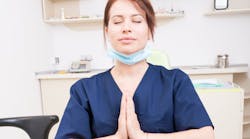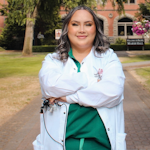Promoting health and wellness of dental professionals throughout their career
After spending so much time and money on your dental hygiene career, it’s critical to invest in yourself by taking care of your mind, body, and soul. Recently, the average career life span of a dental hygienist has been reduced due to occupational stressors, work overload, and, most predominantly, emotional and physical burnout.1 What interventions can be implemented to promote health and wellness for hygienists that will positively impact career longevity?
The effects the job has on your body
Even while focusing on correct ergonomics, there will always be patients who can’t lean back all the way in the chair, turn their heads, or open their mouths wide enough. As a clinician, you end up twisting and bending to be able to see the oral cavity from those impossible spots. By the end of the day, your neck and back are aching and sore. If it’s not our backs or necks hurting, it’s our hands. We know all too well the hand fatigue that occurs after a tough SRP.
Diving into research in this area, we found there are multiple references indicating that dental professionals are prone to occupational health problems. Some of the physical issues identified in dentistry are musculoskeletal disorders (MSDs), eye injuries, vibration-induced neuropathy, stress, burnout, mercury-related occupational health issues, and hearing loss.2,3
You may also be interested in ... Wellness for dental hygiene professionals: It starts with you
One study revealed that “the prevalence of hand and finger symptoms was high among dental hygienists, with a high rate of upper extremity tendinitis. The job-related activities of dental hygienists, including the use of vibratory tools and the repetitive nature of their work, places these practitioners at risk for MSDs of the hands … neck, shoulder, and lower back.”3
Dental hygienists experience not only physical pain but also the stress that comes from working in a dental office.4 Most hygienists can relate to occupational stressors, including difficult patient cases (either clinically or due to patient management). Scenarios such as patients showing up late, working through tenacious calculus, or dealing with uncooperative patients can leave the clinician with the decision of making the next patient wait or working past lunch to catch up. It’s not uncommon to compromise a few precious minutes to grab something to eat or use the restroom, just to stay on schedule.
A recent study of 763 dental hygienists collected trends on occupational stressors, opinions, and attitudes by asking 48 questions related to occupational burnout. The survey was sent to state dental hygiene associations and four dental hygiene professional Facebook groups. The key findings were that dental hygienists reported feeling overworked, anxious, depressed, and affected by the emotional demands of the job. A few of the job stressors were lack of support from coworkers, low job satisfaction, no work breaks, and anxiety from role competition with dentists.5
Maintaining longevity of a healthy career
Long working hours, office dynamics, and static positioning from a dental hygienist’s daily job functions can lead to physical and mental health disturbances.1-4 There are multiple preventive measures that can contribute to a long and healthy career, including physical therapy, chiropractic care, and massage therapy. We repeatedly encountered the multiple benefits of yoga, which has been shown to be an effective preventive measure to reduce physical pain and stress for dental professionals.5
Relax and take a deep breath
We worked with a certified yoga instructor, Emily Fasnacht, to learn more about yoga and its specific benefits for those working in a dental office. Emily has worked with dental hygienists and understands the physical and emotional burnout they experience. She created a 10-minute yoga flow that targets the most reported MSDs and incorporates breathing exercises to reduce stress. We felt it was important to create an easy flow that would fit all dental hygienists’ lifestyles.
More about wellness ... Self-care and the modern dental hygienist
This yoga flow is performed seated and does not require any special equipment, which makes it easier to add to your daily routine. This quick yoga flow can be done in the dental office, between patients, during lunchtime, or after a long day to help you unwind. Emily recommends that dental professionals do the yoga flow at least three times a week to see the benefits.
10-minute yoga flow
Settle into a comfortable seat:
- Shrug/roll the shoulders.
- Shake out the wrists.
- Soften the gaze or close the eyes.
- Bring awareness to the breath.
Take a cleansing breath. Softly blow all air out of the lungs, deeply inhale through the nose to fill the lungs, hold at the top for one count, and sigh air out of the mouth.
Wrist stretches:
- Press the palms together at the heart’s center.
- Rotate the fingertips toward and away from the body (five times in each direction).
- Keep a slow, steady breath.
- Soften the shoulders, with tension only in the forearms and wrists.
- Release the palms and press the backs of the hands together.
- Rotate fingertips toward and away from the body (five times in each direction).
- Spend extra time in any sticky spots.
- Keep a soft, slow breath.
Take a cleansing breath.
Seated cat cow:
- Inhale to broaden collarbones, arch the back, and lift the gaze.
- Exhale to round the back, tuck the tailbone, and tuck the chin.
- Continue at the pace of your breath (10 times cat and cow).
Take a cleansing breath.
Neck rolls:
- Inhale and roll the right ear to the right shoulder.
- Exhale and roll the chin to the chest.
- Inhale and roll the left ear to the left shoulder.
- Exhale and roll the chin to the chest.
- Continue at the pace of your breath (five times on each side).
Take a cleansing breath.
Breath practice:
- Inhale through the nose into the belly for a count of four.
- Pause for a moment at the top.
- Exhale from the belly through the nose for a count of six.
- Pause for a moment at the bottom.
- Continue the four/six breath count with pauses for 10 rounds.
Take a cleansing breath.
Return to natural breath:
- Gently flutter the eyes open and notice how you feel.
A longer, healthier career
We aim to promote the prevention of MSDs and stress-reducing strategies in dental professionals. Our overall conclusion was that there are many benefits of yoga (including core stability and general muscle strength to maintain adequate ergonomics) for reducing physical aches and pains and calming the nervous system for stress reduction. Establishing a routine that enforces physical and mental wellness early in a career, such as practicing yoga regularly, can contribute to increasing career longevity.
Editor's note: This article appeared in the November/December 2023 print edition of RDH magazine. Dental hygienists in North America are eligible for a complimentary print subscription. Sign up here.
References
- Malcolm N, Boyd L, Giblin-Scanlon L, Vineyard J. Occupational stressors of dental hygienists in the United States. Work. 2020;65(3):517-524. doi:10.3233/WOR-203106
- Moodley R, Naidoo S, van Wyk J. The prevalence of occupational health-related problems in dentistry: a review of the literature. J Occup Health. 2018;60(2):111-125. doi:10.1539/joh.17-0188-RA
- Parsons JL, MacDonald L, Cayer M, et al. Functional fitness for dental hygiene students: does it make them fit to sit? Can J Dent Hyg. 2019;53(3):149-156.
- Dental workforce shortages: data to navigate today’s labor market. ADA Health Policy Institute in collaboration with American Dental Assistants Association, American Dental Hygienists’ Association, Dental Assisting National Board, and IgniteDA. October 2022. https://www.ada.org/-/media/project/ada-organization/ada/ada-org/files/resources/research/hpi/dental_workforce_shortages_labor_market.pdf
- Alire E, Brems C, Bell K, Chiswell A. The role of yoga in treating stress-related symptoms in dental hygiene students. Int J Yoga. 2020;13(3):213-222. doi:10.4103/ijoy.IJOY_5_20
Maria Almonte, BSDH, is a graduate of the School of Dental Hygiene at Pacific University in Hillsboro, Oregon.
Denise Jauregui, BSDH, is a graduate of the School of Dental Hygiene at Pacific University in Hillsboro, Oregon.
Yuliana Martinez, BSDH, is a graduate of the School of Dental Hygiene at Pacific University in Hillsboro, Oregon.
Emily Fasnacht, RYT 200, ACE CPT, is a registered yoga teacher and certified personal trainer. She completed yoga teacher training in 2016 with Sacred Jade Yoga, an Ashtanga discipline studio. In 2019, she earned her ACE personal trainer certification and expanded her knowledge of functional movement and fitness programming. She often incorporates Eastern and Western movement philosophies into her programming, including breath work, functional movement, mindfulness, and neuroplasticity. She currently is a grants associate for a community health center.
Melody McGee, MBA, RDH, EPDH, is an assistant professor in Pacific University’s dental hygiene studies program, in Hillsboro, Oregon. She has spent the last 10 years as a clinical dental hygienist, primarily treating periodontally involved patients. She obtained her bachelor’s in dental hygiene studies from Pacific University and a master’s in business administration from Colorado Tech University. Her focus is developing new dental hygiene leaders through real-world experience while serving as a dedicated, compassionate mentor.
















